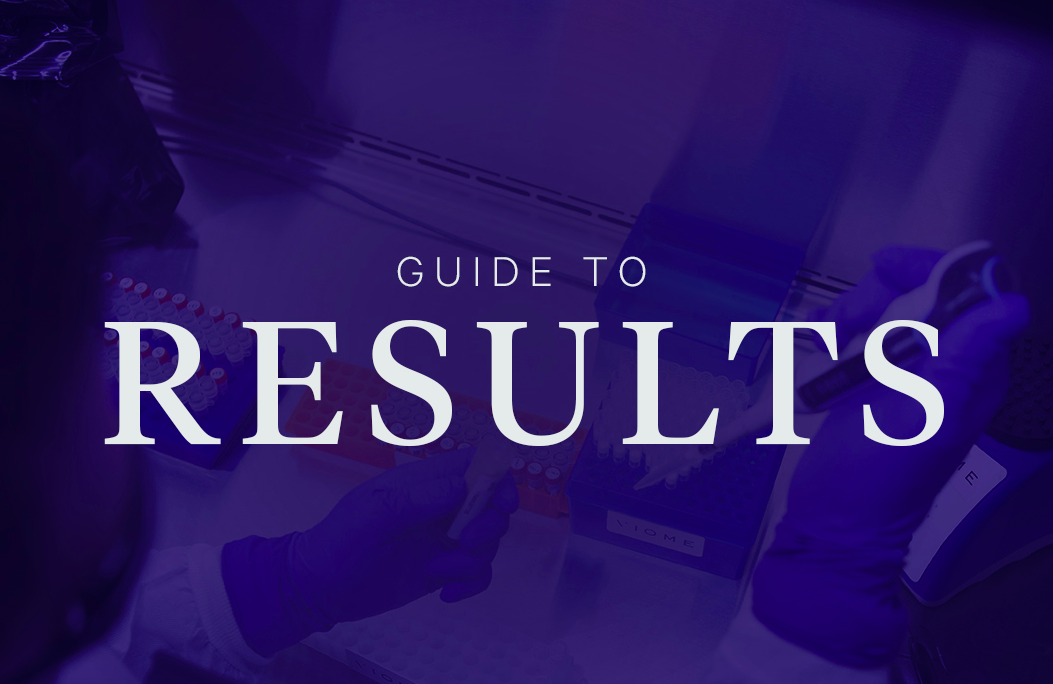You've received your Viome test results… Now what?
Going through your app or website screens you might find yourself wondering – How did we get all those scores and why do they matter?
Many keywords are defined in the app, and the results offer a brief explanation each, but here we are going to talk about how these different pieces are tied together.
We are excited to share with you the scientific vision behind your Viome scores.
We See It – Therefore It’s Active
One of the reasons the word “activity” shows up so frequently in Viome’s app and web content is this:
Our unique laboratory technology, called metatranscriptomics, sequences RNA (not DNA) from each sample. Making RNA from DNA is called “transcription.” You can get DNA even from dead organisms, but only live organisms can be actively transcribing RNA. Viome focuses on the live organisms, so just the mere fact that we are able to detect transcription of something means it is alive and active in your gut!
Viome Focuses on What the Microbes Are Actively Doing
Our high-resolution technology allows us to see down to strain-level how active any bacteria, archaea, eukaryotes, and viruses are in your gut. What is especially exciting, is that we can also see what metabolic and signaling pathways are being activated and to what degree – in other words, what your microbes are doing.
We have a proprietary method of analyzing and scoring biological pathways. Our assessment of these custom-built biological pathways is another reason you see the word “activity” a lot. When you see the phrase, “Pathway Activity,” it’s referring to what your microbes are actively doing.
What your microbes do in the colon depends on:
- what we give them (like food components, elements in drinks, etc.)
- what we expose them to in the gut environment, like toxins, or substances of our digestive system (bile acids, cholesterol, etc.).
To see this information and tell you what happens next, we identify and examine pathways. These biological pathways are sequences of molecular events that tell a story, step-by-step, from beginning to the end. For example:
- Which beneficial products might be made by your microbiome and from what materials?
- What are your microbes busy processing or degrading?
- What kinds of signals are they communicating with each other and with you?
- What are your microbes using for energy?
- Which carbohydrates are they consuming, glucose or fructose, or more complex starches?
- Which microbial activities may be harmful to you?
- What do the microbes reflect about your diet and your GI environment?
You may be familiar with more famous pathways like Glycolysis or the Krebs Cycle (a.k.a. TCA cycle). These are essentially the processes of turning carbs into energy. These are some examples of what pathway analysis shows us. Details like this give us a clearer picture of what’s really happening.
No other company can see with molecular-level precision what’s going on in the gut microbiome from this functional viewpoint. Without this perspective, it would be very hard to predict what your microbes are actively doing to each other and to you – the host. We also have a clearer picture of what you might be doing (right or wrong) to your gut and your microbiome – whether you’re being a “good host” and what you can do to improve.
When we take a closer look at how your scores are derived, you will be able to see these two key data analysis components that we always strive to incorporate into our scoring:
1. Taxonomy Analysis: The organisms – who they are, what are they known for, and how active they are in your sample.
2. Pathway Analysis: Biological pathway activity levels – this is what offers insights into what the microbes are actively “doing.”
Having both of these perspectives is what allows us to really personalize your results insights and recommendations.
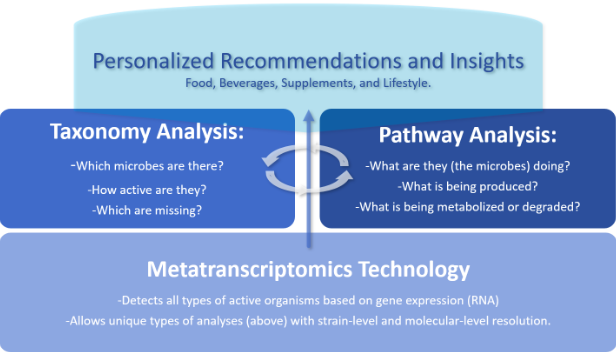
There is a tremendous amount of data gathered and analyzed from every sample at Viome. This type of data is novel, revolutionary, and quite complex. Your scores are prioritized to offer insights that are most actionable for you.
Making a comprehensive microbiome assessment to create meaningful scores for related wellness, diet, and supplement recommendations is like building an architectural feat that has never been done before, brick by brick. This Translational Science effort is what allows the information gathered from thousands of data points to be “translated” into action that can play a valuable role in your personal wellness journey.
A Closer Look at Your Viome Scores
Current Scores:
Metabolic Fitness – This score reflects your microbiome’s activities and functions related to weight and blood sugar regulation. The higher the score, the better.
Inflammatory Activity – This score assesses your microbiome’s activities and functions related to inflammation. Microbial inflammation patterns may be sometimes associated with inflammation in your body, which, to various degrees, is a known common underlying factor in many chronic diseases. Aim for a lower score.
Coming Soon:
Digestive Efficiency – This score is your microbiome’s reflection of your digestive processes. Aim for a higher score.
Detox Potential – This score reflects your microbiome’s ability to mitigate any toxicity or oxidative stress, and whether your microbes are actively detoxifying toxins you may be exposed to. The higher the score, the better.
Gut-Neuro Connection – This score evaluates your microbiome’s communication with your nervous system.
Now let’s see how it comes together…
How We Derive Your Microbiome Scores
We do not test any metabolites or chemicals themselves, but we do evaluate various microbial activities and functions based on the RNA and expression data collected with our metatranscriptomics technology. The insights and recommendations we offer are based on the following two types of assessments, as mentioned above: 1. Taxonomy Analysis and 2. Pathway Analysis.
These two analyses make up complementary components of different functional categories. Multiple categories are then taken integratively and are used in the microbiome scores you can see in the app, such as Inflammatory Activity, Metabolic Fitness, and soon will include other areas, such as Digestive Efficiency, Gut-Neuro connection, and Detox Potential.
We may separately highlight some of the specific pathway scores in your results, as well. For example, you may have seen butyrate production results, and will also see other assessments, like LPS biosynthesis and sulfide production soon.
Your recommendations can be based on a cumulative integrative score, like Inflammatory Activity, and can also come from specific pathway details observed or specific organisms active or missing.
- Pro-inflammatory category includes some of the following examples:
- Taxa:
- Well-known proinflammatory species, including those in the class Gammaproteobacteria, genus Salmonella, and other opportunists, like Clostridioides difficile
-
Pathways:
- Different types of lipopolysaccharides (LPS) and their inflammatory status.
- We look at flagella, the little tails on microbes that help them move. Flagella are indicators of an inflammatory environment because it means organisms are trying to either get away from or move towards something. In addition, some opportunistic organisms have flagella, so it may signal that there are such microbes present.
- Pathways where microbes produce proinflammatory metabolites as byproducts. An example of this would be ammonia or sulfide gas.
- Anti-inflammatory category includes some of the following:
- Taxa:
- All anti-inflammatory species, including those in the genera Lactobacillus and Bifidobacterium (you may recognize these because many known probiotic species and strains come from these genera)
- Butyrate-producing microbes.
- Pathways:
- Butyrate production and other anti-inflammatory pathways, like particular bile acid metabolism.
We then reconcile the activity of these two contrasting functional categories to get your total Inflammatory Activity Score:
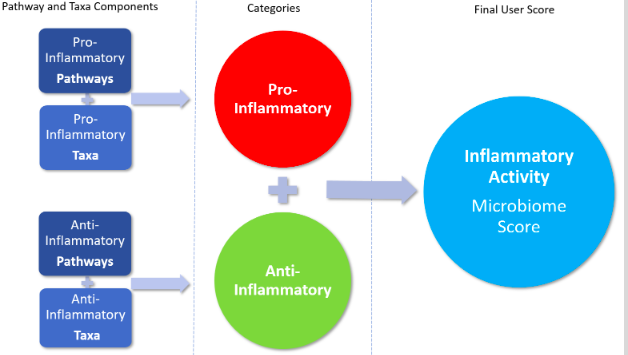
Metabolic Fitness Score follows a very similar overall process as the Inflammatory Activity Score:
There are two contrasting microbial categories associated with Metabolic Fitness, healthy and unhealthy, each compiled from their own respective taxa and pathway components. These functional categories then get reconciled into the final Metabolic Fitness microbiome score.
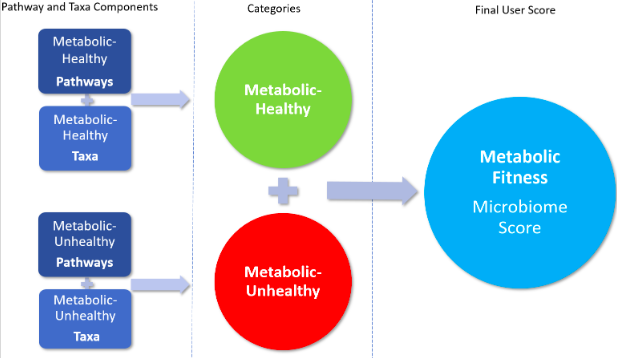
Function is another commonly used word in relation to microbiome analysis and functional medicine. It’s important to clarify the level of function being implied.
For example, on the most granular gene level, each protein that gets encoded by a gene (expression of which we measure) can have a function. For example, a phosphatase is a protein with an enzymatic function that removes a phosphate group from particular molecules. Aminotransferases transfer “amino-” groups (consisting of nitrogen and a few hydrogen atoms) from some molecules to others, but this doesn’t reveal overall microbiome functional patterns.
Gene-based functions are the inputs into pathway analyses and scoring. Collectively they can tell stories of the gut microbiome functions at the pathway level. For example, is your gut microbiome making lots of butyrate or degrading your mucosal lining or processing your undigested proteins?
Inflammatory Activity can be seen as a whole functional area and, it is a synthesis of various functional categories, which consist of multiple pathways. Seeing this is possible because of the given expression of the genes with known functions – which is made possible by the metatranscriptomics technology.
Everything cannot be referred to as “Functions,” so let’s summarize the levels involved here, so we can be more specific:
1. Expressed genes have known encoded functions →
2. Then the stories that unravel as a result of analysis of pathways (where genes are a starting data input) give insights into your microbiome functions and functional categories →
3. Which finally tells us about overall health and wellness-related functions.
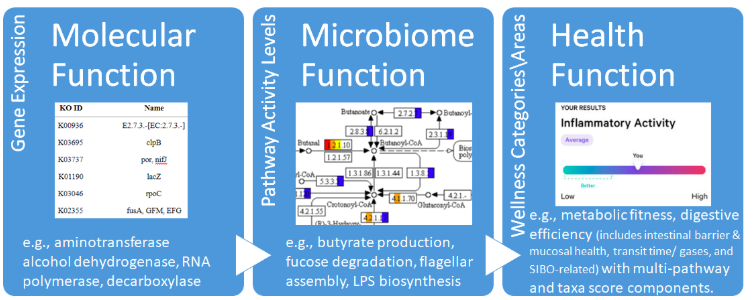
This is how we go from Molecular Functions to Functional Health.
Here is an example using the Butyrate scoring…
Butyrate is a short-chain fatty acid (SCFA) produced by microbes in your gut. It is crucial for your gut, it fights inflammation, influences metabolism, controls appetite, helps with blood sugar balance, and is beneficial for many other areas of health.
What you see in your Viome butyrate results is based on an integrative assessment of two major types of analyses:
1. Butyrate Production Pathways: We assess your microbiome’s butyrate production pathways using gene expression data as inputs. This analytical approach evaluates activity levels of Viome’s scientifically curated and manually reconstructed molecular pathways, which consist of many genes. Depending on the roles of each gene in butyrate production pathways, and their corresponding RNA levels (expression), we report the overall level of activity of your butyrate production pathways as either “High”, “Medium,” or “Low.”
2. Butyrate-producing Bacteria: We assess the relative activity of butyrate-producing microbes, which may or may not be actively producing butyrate. This is why we refer to this part of your result as the active microbiome’s “potential” to produce butyrate. Butyrate producers can also be “High”, “Medium,” or “Low.”
The two butyrate scores integratively yield different recommendations personalized for you, suggesting to either “add good guys” (via more sources of beneficial butyrate producers, like probiotics) or “feed the good guys” (give the butyrate producers what they need to make more butyrate), and/or balance your microbiome in other ways to support the butyrate production.
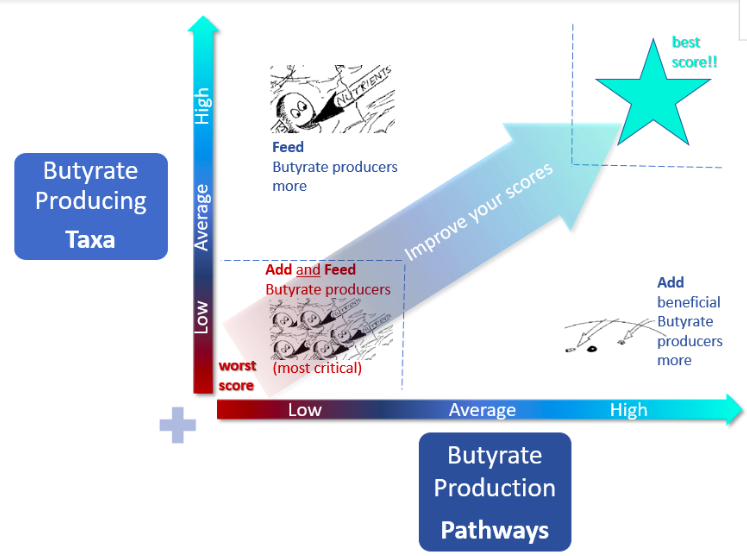
Butyrate scores are taken into account in some functional categories, such as anti-inflammatory, and thus, can play a role in your final user score, such as Inflammatory Activity.
Your recommendations can be affected by or partly derived from your overall Metabolic or Inflammatory activity patterns, or from particular functional categories within those scores, or even from specific pathway results, such as the butyrate example above.
Read more about your Viome recommendations here.
Resources:
